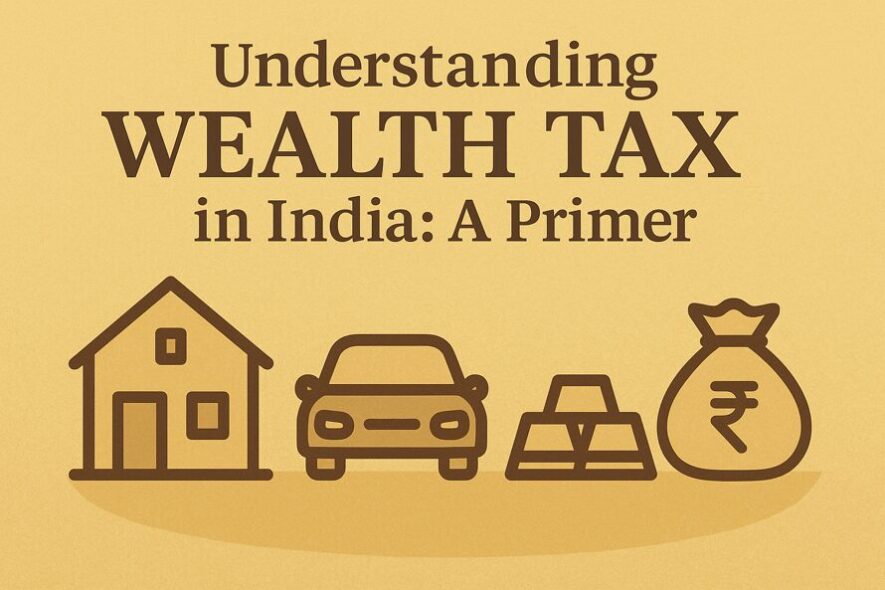
What is Wealth Tax?
When we think of taxes, we think of salary slips, business profits, and GST on bills. But wealth tax? That was a whole different beast. It didn’t bother with your paycheck. It looked at what you already owned. Homes. Cars. Gold kept in lockers. Even yachts, if you ever had one.
The logic sounded fair: if you’ve accumulated more wealth than most, you should share a little more with the government. But how did it actually work? And why did India, after decades, finally shut it down? Let’s peel it layer by layer.
Definition and Concept
The wealth tax was a direct tax on net wealth. Simple definition, tricky execution. Net wealth meant the market value of your assets minus debts owed on them. On March 31 every year, you had to calculate the value of your taxable wealth and, if it crossed the threshold, pay up.
Unlike income tax, which looks forward every financial year, wealth tax looks at your existing pile. That distinction made it controversial from day one.
Historical Background of Wealth Tax in India
India rolled it out in 1957. Fresh from independence, the government wanted to curb inequality. We weren’t alone; many nations experimented with wealth taxes in the mid-20th century. For nearly six decades, Indians filed separate wealth tax returns along with income tax.
But the yield? Always tiny. By the early 2000s, the wealth tax looked more like an old relic sitting on the shelf than a serious revenue tool.
Why Was Wealth Tax Introduced?
The intent was noble. Policymakers thought taxing accumulated wealth would curb the extreme concentration of wealth and bring fairness. Luxury and idle assets were the target, not working capital or family homes. The government wanted the richest to chip in more toward nation-building.
On paper, it sounded progressive. In practice, it was messy. Valuing assets every year was a headache. Enforcement dragged on in disputes. And slowly, the tax turned into a compliance burden rather than a redistributive force.
Applicability of Wealth Tax in India (Before 2015)
For those years when wealth tax applied, it wasn’t universal. Only certain people, specific assets, and certain values came under its net.
Who Was Liable to Pay Wealth Tax?
The tax applied to individuals, Hindu Undivided Families (HUFs), and companies. Non-residents weren’t spared either; if they held taxable assets in India, they paid. Firms and partnerships were exempt.
What Assets Were Taxable?
Here’s where it got interesting. The law listed specific “luxury” assets:
- Real estate, except for one self-occupied house.
- Motor cars not used for business.
- Jewelry, bullion, gold, and precious stones.
- Yachts, boats, and aircraft (unless for business).
- Urban land held as investment.
It wasn’t about every single thing you owned. It was about the things that symbolized wealth.
Threshold Limits and Rates
By its final years, the bar was ₹30 lakh. If your net wealth went above it, you paid a flat 1% on the excess.
Exempted Assets
Not everything was taxable. Agricultural land stayed exempt. So did commercial properties used for business, under-construction property, and stock-in-trade. And you could keep one residential house tax-free.
The exemptions made sense; they ensured productive assets weren’t penalized. The focus stayed on luxury or idle wealth.
Abolition of Wealth Tax in 2015
By 2015, the writing was on the wall. The wealth tax was costing more to run than it was bringing in.
Budget 2015 Announcement and Rationale
In his Budget 2015–16 speech, Finance Minister Arun Jaitley called wealth tax “low-yield, high-cost.” He wasn’t exaggerating. The government spent more on administration than it earned from collections. Just about ₹1,000 crore a year came in, barely enough to dent fiscal numbers.
So the axe fell. The wealth tax was gone.
Shift to Surcharge on High-Income Individuals
But the government didn’t let the wealthy walk away free. Instead, it introduced a 2% surcharge on individuals earning over ₹1 crore annually. The logic was clever: income is far easier to track than wealth valuations. Collections shot up immediately, compliance got easier, and disputes reduced.
Impact on High Net-Worth Individuals (HNIs)
For HNIs, it was a relief. No more filing separate wealth tax returns, no more annual jewelry valuations, no more tussles over property values. Sure, the surcharge still bit into incomes, but at least it was clean and straightforward. The mood was: pay up, move on.
Wealth Reporting Under the Current Tax Regime
Now, just because the wealth tax vanished doesn’t mean the government stopped keeping an eye on wealth. Instead, it moved the responsibility for disclosure to income tax returns.
Statement of Assets in ITR for High-Income Taxpayers
If your total income crosses ₹50 lakh a year, you must file a statement of assets and liabilities. This means listing out land, buildings, vehicles, jewelry, and financial assets.
ITR Forms with Asset Disclosure Requirements
Forms like ITR-2 and ITR-3 now have these sections. Taxpayers need to break down what they own, sometimes even giving values. It’s less about taxing the wealth directly and more about transparency.
Role in Tax Scrutiny and Assessment
The disclosures help authorities match lifestyles with declared incomes. If someone shows ₹15 lakh annual income but reports three bungalows and two sports cars, alarm bells ring. Wealth reporting has become a silent but powerful tool in assessments.
Global Perspective: How Other Countries Handle Wealth Tax
India may have dumped wealth tax, but globally, the debate still rages.
France, Norway, and Spain Examples
- France ran a wealth tax for decades before narrowing it down to real estate, after wealthy families began shifting capital abroad.
- Norway continues to levy a wealth tax, including on overseas assets of residents, making it one of the strictest systems.
- Spain allows regions to decide rates, and some still collect significant sums through it.
These examples show how countries tweak wealth tax to balance revenue with investor sentiment.
OECD Debates on Wealth Tax
The Organization for Economic Cooperation and Development (OECD), a club of rich, industrialized countries, regularly reviews wealth taxes. Some economists argue they help fight inequality. Others counter that the rich simply move assets offshore, making the tax toothless. Alternatives like inheritance tax or luxury taxes on consumption often come up as more effective ways of taxing wealth.
Future of Wealth Tax in India: Will It Return?
Every few years, the idea of bringing wealth tax back surfaces. Rising inequality keeps the conversation alive.
Political and Economic Debates
Supporters argue India’s billionaires control outsized portions of wealth, and taxing them could fund welfare. Critics remind us of the 2015 experience: high cost, low returns, endless disputes. It’s a tug-of-war between equity and efficiency.
Alternate Proposals (Inheritance Tax, Luxury Tax)
Instead of reviving the wealth tax, policymakers sometimes suggest an inheritance tax or targeted luxury taxes. These focus on transfers or visible consumption, which are easier to track. Whether these gain traction will depend on the political climate and economic needs.
Conclusion
Wealth tax was once a bold idea: tax the rich not just on what they earn, but on what they own. For almost 60 years, it sat in India’s tax system. Yet, by the end, it was more symbolic than useful.
Its abolition in 2015 simplified life for taxpayers, increased efficiency for the government, and signaled a shift toward income-based surcharges and asset disclosure instead of direct levies.
Still, the ghost of wealth tax lingers. Every budget season, whispers of its return emerge. Whether it comes back or stays buried will depend on how India balances fairness, revenue, and ease of compliance. For now, the wealth tax is history, but the debate around taxing wealth is far from over.
FAQs:
Q. Is there any wealth tax in India right now?
Wealth tax doesn’t exist in India anymore. The government scrapped it in 2015 after realizing that the collections were tiny compared to the cost of running it. In its place, high-income individuals pay an additional surcharge on income above ₹1 crore. While the spirit of taxing the wealthy persists, there’s no separate wealth tax return or levy in place today.
Q. What is the difference between wealth tax and income tax?
Income tax measures your annual earnings, salary, business profits, capital gains, or interest. Wealth tax, on the other hand, looked at what you already owned, like real estate, jewelry, or luxury cars, once they crossed a threshold. In simple terms, income tax was about cash flowing in each year, while wealth tax was about the stock of assets you held at a fixed date.
Q. Do NRIs have to worry about wealth tax in India?
No. Before 2015, NRIs with taxable assets in India, say, an apartment in Mumbai or jewelry stored in the country, had to file wealth tax returns if the value exceeded the threshold. Since its abolition, NRIs only need to think about income tax in India, which applies to income earned or received here. Asset disclosures may still apply to specific categories, but wealth tax as a levy is off the table.
Q. What were the penalties for not paying wealth tax?
Non-payment of wealth tax wasn’t taken lightly. If someone skipped filing or underreported assets, penalties kicked in, along with interest on unpaid amounts. In serious cases, prosecution could follow. The idea was to keep taxpayers honest, even though the tax itself brought in very little revenue.
Q. Is disclosure of assets still required in ITR?
Yes, but with a twist. Even though the wealth tax is gone, the government still wants visibility into high-value assets. Anyone with an annual income above ₹50 lakh has to declare details of assets and liabilities in their income tax return. This includes properties, vehicles, jewelry, financial investments, and loans. The disclosures aren’t taxed separately, but they give tax authorities a way to cross-check lifestyle against reported income.
Q. Can wealth tax be reintroduced in the future?
It’s always possible. Every few years, especially during debates on inequality, the idea of a wealth tax comes back. Some policymakers argue that taxing the rich more directly could fund welfare programs. Others say it would discourage investment and repeat the problems that led to its scrapping. While nothing is currently on the horizon, political shifts and economic pressures could bring it back into the conversation.




